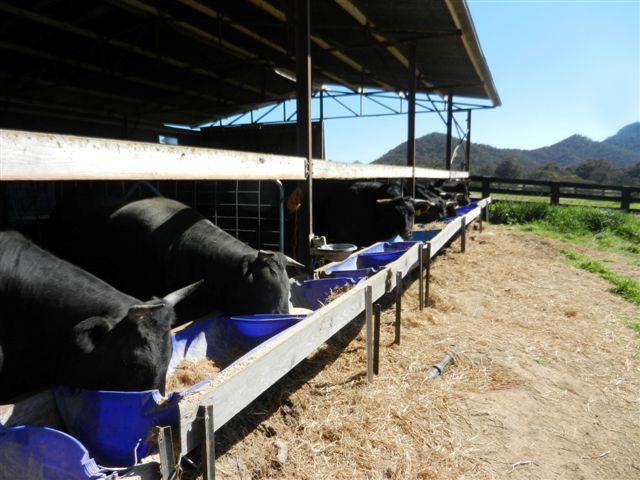Wagyu Predictive Systms
Crossbred (XB) Predictive Systems
Australian sire selection in crossbreeding is largely predicated by feedlot buyers, specifying in reference to carcass summaries as recorded in feedlot carcass databases. Derived from these databases, early, largely anecdotal Wagyu sire ranking information relates mainly to this XB production, using high Tajima (Hyogo) strain bloodline sires.
High Tajima strain specification is based on the traditional prefecture/trait relationships mentioned above – Tajima is strongly identified with marbling performance (but relatively low growth). So Australian XB specification of high Tajima sires has effectively become a ‘default setting’ for marbling. Within the specification, any reduced progeny growth possibility in the XB joining is theoretically addressed by dam (often Angus) genetics.
In implementing this ‘default selection’ to Tajima bloodlines, and for most of the entire history of Australian Wagyu production, the feedlot livestock buyers who ‘advise’ XB producers on sire selection have consistently specified sons of the same first generation Tajima sires. This long-standing specification of a short sire list is supported by science supporting consistent levels of marbling heritability in Wagyu, but fails both to recognize that identical heritability factors apply to all Japanese Blacks – not just Tajima sons; and that NOT all high Tajima sons are high marbling. In the event, lower-Tajima sires are rarely considered and in this scenario there can be little or no genetic progress in XB Wagyu breeding driven from the sire side.
An informal survey of major Australian feedlots and live exporters in late 2013 revealed that most continue to mandate a high Tajima son specification for XB suppliers – some seeking as high as 75% Tajima content in XB producer sire specifications. And there are no industry-wide or publically reviewed independent genetic development programs in Australian Wagyu XB production to challenge the ‘traditional specification’, despite the overall economic dominance of this sector in the local Wagyu industry.
As a result, breeding of F1 sires to the generic feedlot buyer specification is a ‘no brainer’: simply put ‘feedlot approved’ first generation 100% Tajima sires over FB dams sired by another consistently specified high Tajima sire – for a 75% or higher Tajima calf crop in which males are destined to become F1 paddock sires. These prospective F1 sires are usually approved on pedigree paperwork alone, so no additional selection tools are required.
Only in Hyogo is selection to a single prefectural bloodline so rigidly enforced, and no further discussion of predictive tools for XB Wagyu is currently necessary in the Australian context.

Fullblood (FB) Predictive Systems
As in crossbreeding, in Australian Fullblood feeder production there is no public domain, national carcass database to enable precise performance ranking of locally-available sires, even including first generation AI sires imported from Japan well over a decade ago. There is the same low probability that such a database will ever become available, due to proprietary, competitive pressures. And as in the XB industry, prior to the recent GEBV initiative, Fullblood carcass data generally has been available only to producer/suppliers from feedlotter/processors, who provide synopsis data.
In 2015, major feeders such as AACo now run entirely in-house EBV and genetics management programs, but have in the past provided substantial carcass data. Others, such as Blackmore Wagyu, have withdrawn from the on-line AWA database. Major feeders of Fullbloods that continue to contribute to AWA carcass data collection include Mayura Station and Macquarie Downs, with many smaller feeder producers. Mechanisms for incorporating feedlot carcass data were under investigation in early 2015.
The first limited ‘public showing’ of progeny carcasses of Australian fine marbling fullblood sires commenced from the 2011-2012 ‘Beyond BMS 9’ sessions at AWA AGMs, which identified a short list from Australian FB carcass images captured during the preceding year, using the Japanese digital imaging technology currently employed in carcass EBV research. Progress research EBVs were previewed at the AWA Wagyu conferences in 2013 and an initial Research Sire/Dam Summary published in 2014.
New GEBVs – combining existing Wagyu EBV data with the new research values based on carcass image data – are expected in 2015. Details from the original announcement of the new generation EBV are available in the AWA Update Magazine #48, here. An impressive potential outcome of the genomic project is the possibility of a test to predict the performance of young Wagyu – representing substantial savings in time and risk. Dr Banks discussed this, and the entire project, with Beef Central journalist Jon Condon, here.
Let’s Talk About Your Wagyu Breeding Plan
We'll Find the Right Wagyu Breeding Solution for You
Call us:
